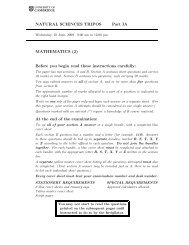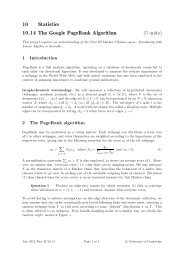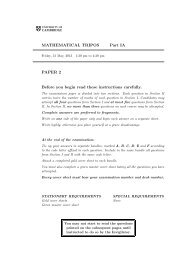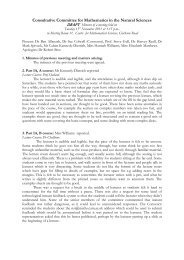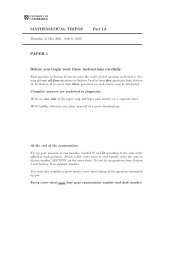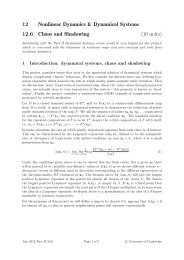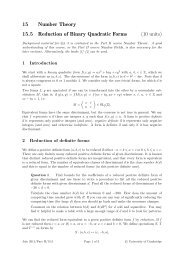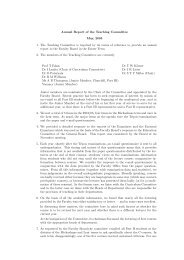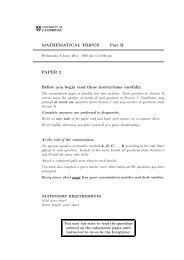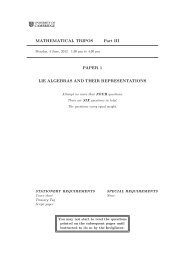MATHEMATICAL TRIPOS Part II PAPER 3 Before you begin read ...
MATHEMATICAL TRIPOS Part II PAPER 3 Before you begin read ...
MATHEMATICAL TRIPOS Part II PAPER 3 Before you begin read ...
- No tags were found...
Create successful ePaper yourself
Turn your PDF publications into a flip-book with our unique Google optimized e-Paper software.
13A Mathematical BiologyAn activator-inhibitor system is described by the equationswhere a, b, d > 0.∂u∂t∂v∂t7= ∂2 u∂x 2 + u − uv + au2 ,= d ∂2 v∂x 2 + u2 − buv ,Find and sketch the range of a, b for which the spatially homogeneous system hasa stable stationary solution with u > 0 and v > 0.Considering spatial perturbations of the form cos(kx) about the solution foundabove, find conditions for the system to be unstable. Sketch this region in the (d, b) planefor fixed a ∈ (0, 1).Find k c , the critical wavenumber at the onset of the instability, in terms of a and b.14C Dynamical SystemsLet f : I → I be a continuous map of an interval I ⊂ R. Explain what is meantby the statements (a) f has a horseshoe and (b) f is chaotic according to Glendinning’sdefinition of chaos.Assume that f has a 3-cycle {x 0 , x 1 , x 2 } with x 1 = f(x 0 ), x 2 = f(x 1 ), x 0 = f(x 2 ),x 0 < x 1 < x 2 . Prove that f 2 has a horseshoe. [You may assume the Intermediate ValueTheorem.]Represent the effect of f on the intervals I a = [x 0 , x 1 ] and I b = [x 1 , x 2 ] by means ofa directed graph. Explain how the existence of the 3-cycle corresponds to this graph.The map g : I → I has a 4-cycle {x 0 , x 1 , x 2 , x 3 } with x 1 = g(x 0 ), x 2 = g(x 1 ),x 3 = g(x 2 ) and x 0 = g(x 3 ). If x 0 < x 3 < x 2 < x 1 is g necessarily chaotic? [You may usea suitable directed graph as part of <strong>you</strong>r argument.]How does <strong>you</strong>r answer change if x 0 < x 2 < x 1 < x 3 ?<strong>Part</strong> <strong>II</strong>, Paper 3[TURN OVER



